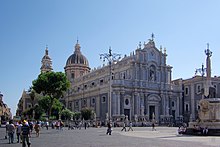Cathedral of Catania
| Metropolitan Cathedral of Saint Agatha Cattedrale metropolitana di Sant'Agata |
|
|---|---|

Catania Cathedral
|
|
| Basic information | |
| Location | Catania, Italy |
| Geographic coordinates | 37°30′09″N 15°05′17″E / 37.50250°N 15.08806°ECoordinates: 37°30′09″N 15°05′17″E / 37.50250°N 15.08806°E |
| Affiliation | Roman Catholic |
| Rite | Roman |
| District | Archdiocese of Catania |
| Ecclesiastical or organizational status | Cathedral |
| Architectural description | |
| Architectural type | Church |
| Architectural style | Norman and Baroque |
Catania Cathedral (Italian: Duomo di Catania; Cattedrale di Sant'Agata), dedicated to Saint Agatha, is a Roman Catholic cathedral in Catania, Sicily, southern Italy. It was the seat of the Bishops of Catania until 1859, when the diocese was elevated to an archdiocese, and since then has been the seat of the Archbishops of Catania.
The cathedral has been destroyed and rebuilt several times because of earthquakes and eruptions of the nearby Mount Etna. It was originally constructed in 1078-1093, on the ruins of the ancient Roman Achillean Baths, by order of Roger I of Sicily, who had conquered the city from the Islamic emirate of Sicily. At the time it had the appearance of a fortified church (ecclesia munita).
In 1169 it was almost entirely destroyed by an earthquake, leaving only the apse area intact. Further damage was caused by a fire in 1169, but the most catastrophic event was the 1693 earthquake, which again left it mostly in ruins. It was subsequently rebuilt in Baroque style.
Today, traces of the original Norman edifice include part of the transept, the two towers and the three semicircular apses, composed of large lava stones, most of them recovered from imperial Roman buildings.
The current appearance of the cathedral dates from the work in 1711 of Gian Battista Vaccarini, who designed a new Baroque façade after the 1693 earthquake. It has three levels with Corinthian columns in granite, perhaps taken from the Roman Theatre of the city. All the orders are decorated with marble statues of Saint Agatha over the gate, Saint Euplius on the right and Saint Birillus on the left. The main door, in wood, has 32 sculpted plaques with episodes of the life and martyrdom of Saint Agatha, papal coats of arms and symbols of Christianity.
...
Wikipedia
